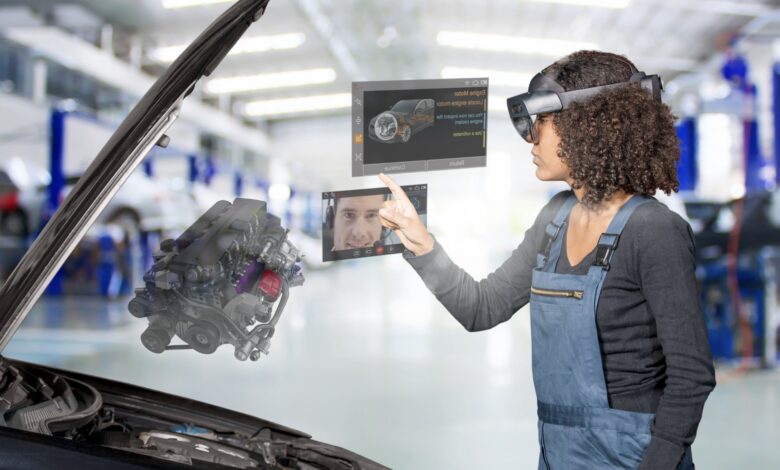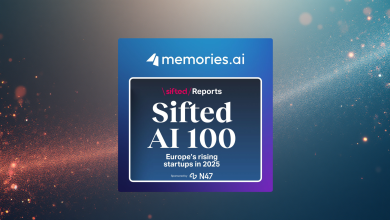
The past year has seen a consistent stream of AI headlines, including on the latest generative AI models, such as ChatGPT, Gemini, and Mistral. While they’ve captivated the world, those embedded in the tech industry will know that AI has been shaping our day-to-day lives for longer than many people realise. For example, in the form of Augmented Reality (AR) and Mixed Reality (MR). Here the magic isn’t just about dazzling digital overlays on the real world, but about the AI power running beneath the surface.
The Role of AI in AR
AR is a seamless blend of real and virtual worlds. But building the bridge between the two realms requires more than just steel and concrete. It demands precise mapping, constant analysis, and real-time adaptation. This is where AI steps in, acting as the architect, cartographer, and traffic controller of this digital-physical fusion.
Mapping the Digital Landscape: How AI Creates Your AR World
So, how does this invisible engine work? Smart glasses and mobile devices are crammed with sensors, constantly feeding data about your surroundings to the AI brain. This raw data, a cacophony of light, sound, and movement, needs to be transformed into a digital representation of your environment. This is where AI’s “mapping” function comes into play.
Imagine constructing a digital blueprint of your entire factory. Every workstation, production line, and even individual tool becomes meticulously mapped, forming a 3D landscape that’s far more than just physical space. This intricate digital map captures vital information – inventory levels, maintenance schedules, equipment status, and even worker locations. This becomes the foundation upon which AR annotations are layered, allowing virtual objects to appear naturally integrated into your physical space.
Beyond Mapping: AI as Your Intelligent Assistant in AR
But the original mapping is just the beginning. The real magic happens when AI starts analysing this constantly evolving digital landscape. Every movement of your head and every object you point at, all become inputs for the AI engine. It deciphers meaning from this data stream, understanding context and intent. Think of it like having a super-intelligent assistant constantly reading your mind and anticipating your needs.
From Mechanic to Surgeon: How AI Enhances Efficiency and Accuracy
This analysis fuels a multitude of applications. For workers in various industries AR becomes more than just a cool new feature. Imagine a mechanic wearing smart glasses equipped with AI. As they inspect a complex engine, relevant information about specific parts pops up directly in their field of view, highlighting potential issues and guiding them through repair procedures. Or picture a surgeon performing a delicate operation with AI-powered AR visualising critical medical scans directly onto the patient, providing real-time guidance for improved accuracy. Whilst this concept seems like a long way off, it is the future of a lot of industries that require a high level of skill and attention to detail.
From Efficiency Coach to Fatigue Guardian: AI Optimises Your Work
Beyond visual assistance, AI also takes on the role of a silent efficiency coach. It analyses worker behaviour, identifying repetitive tasks like scanning items or checking inventory. Based on these patterns, it can suggest optimisations like rearranging stock locations or introducing automation tools, minimising unnecessary time and effort. But AI doesn’t stop there. It can even monitor worker fatigue, surveying physical movements and exertion levels. When fatigue threatens to impact
productivity or safety AI can step in, suggesting shift adjustments or exhaustion-reducing measures, ensuring worker well-being and optimal performance.
Predicting the Future: AI as a Proactive Partner
This real-time data analysis is the heart and soul of AI’s role in AR. It’s not just about identifying patterns; it’s about drawing conclusions and providing valuable suggestions. Imagine an AI system analysing data from an assembly line, identifying bottlenecks, and predicting potential equipment failures before they happen. Based on these insights, AI can recommend proactive maintenance or schedule production adjustments, preventing downtime and ensuring smooth operations.
From Analysis to Automation: The Evolving Landscape of AI-powered AR
But the journey doesn’t end there. We’re still in the early stages of this AI-powered AR revolution. Looking ahead, the focus is on shifting from analysis to automation. Imagine smart glasses that not only offer real-time instructions but also automate simple tasks. For example, an AR-powered system that supports you with complex repair procedures, completing specific steps on its own while ensuring your understanding and supervision. This level of seamless human-machine collaboration holds immense potential, not just for industrial applications but for various fields such as education, training, and even everyday tasks.
Navigating the Ethical Maze: Privacy, Bias, and the Future of Work in AI-powered AR
While the magic of AI-powered AR entices, ethical considerations prevail. Privacy concerns simmer as data collected by AR devices raises questions about ownership and purpose-focused usage. Potential biases embedded in AI algorithms could amplify existing inequalities, leading to unfair treatment or discrimination. Perhaps the most unsettling is the possibility of job displacement, which is a big topic for generative AI but is not the case for AR-related AI, as humans is still in the center of all actions. The clue is in the name, augmented reality, as it augments an employee’s work and experience, as opposed to replacing it.
However, developers can mitigate these concerns upfront through transparency and user control over data collection and usage. Responsible development requires diverse teams, validated input and rigorous testing to minimise bias in AI algorithms. Open communication and education is a must to include the existing workforce on this disruptive journey, while retraining programs can help employees to unlock the potential of AI for themselves. Ultimately, a collaborative effort between developers, users, and policymakers is crucial to ensure that AI in AR serves humanity, not the other way around. By prioritising ethical considerations and responsible development, we can unlock the true potential of AR while navigating its challenges with awareness and empathy.
The Invisible Engine: Redefining How We Interact with Technology
So, the next time you encounter AR, take a moment to appreciate the invisible engine powering it. It’s not just about fancy visuals; it’s about intelligent analysis, tireless adaptation, and the potential for automation. This fusion of physical and digital worlds, propelled by the invisible force of AI, is rewriting the rules of how we interact with technology, paving the way for a future that’s smarter, more efficient, and infinitely more adaptable.



